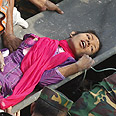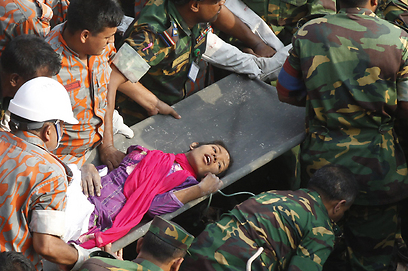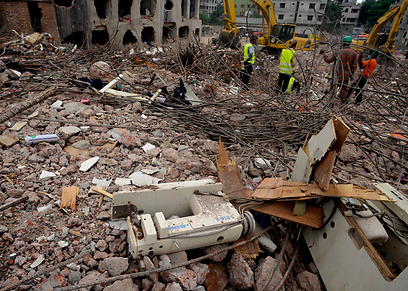
A seamstress buried for 17 days in the wreckage of a collapsed garment factory building was rescued Friday, a miraculous moment set against the unimaginable horror of the more than 1,000 bodies recovered so far.
Reshma was in such good shape she was able to walk, according to one rescuer. She said she survived on dried food and bottled water. She was discovered near a Muslim prayer room in the basement of the eight-story Rana Plaza building, where crews have been focused on recovering bodies, not rescuing survivors, since late April.
Related stories:
- Muslim protests rage on in Nigeria, Bangladesh
- Quake hits near Iran's nuclear city Bushehr, 30 dead
- Southeast Seoul declared 'disaster zone'
"I heard voices of the rescue workers for the past several days. I kept hitting the wreckage with sticks and rods just to attract their attention," she told the private Somoy TV from her hospital bed as doctors and nurses milled about, giving her saline and checking her condition.

Reshma taken to a hospital (Photo: AFP)
"No one heard me. It was so bad for me. I never dreamed I'd see the daylight again," she said.
"There was some dried food around me. I ate the dried food for 15 days. The last two days I had nothing
but water. I used to drink only a limited quantity of water to save it. I had some bottles of water around me," she said.
She finally got the crews' attention when she took a steel pipe and began banging it, said Abdur Razzak, a warrant officer with the military's engineering department who first spotted her in the wreckage. The workers ran into the dark rubble, eventually getting flashlights, to free her, he said.
They ordered the cranes and bulldozers to immediately stop and used handsaws and welding and drilling equipment to cut through the iron rod and debris still trapping her. They gave her water, oxygen and saline
as they worked to free her.

The building's wreckage (Photo: AP)
When Reshma was freed after 40 minutes, the crowd erupted in wild cheers. Soldiers and men in hard hats carried Reshma, wearing a pink outfit with a violet scarf, on a stretcher to a waiting ambulance,
which brought her to a military hospital. But her rescuers said she was in shockingly good condition, despite her ordeal. Razzak said she could even walk.
"She was fine, no injuries. She was just trapped. The space was wide," said Lt. Col. Moyeen, an army official at the scene who uses only one name.
Doctors at the hospital told Bangladeshi television that Reshma was out of danger and her kidney and liver function were fine.
Reshma told Somoy TV she was working in a factory on the second floor when the building began collapsing around her. She raced down a stairwell into the basement, where she became trapped by the wreckage.
Reshma told her rescuers there were no more survivors in her area. Workers began tearing through the nearby rubble anyway, hoping to find another person alive.
"Reshma told me there were three others with her. They died. She did not see anybody else alive there," said Maj. Gen. Chowdhury Hasan Suhrawardy, the head of the local military units. The bodies were eventually recovered from another section of the building not far from Reshma, he said.
Reshma's sister Asma said she and her mother kept a vigil for the seamstress, who is from the rural Dinajpur district, 270 kilometers (170 miles) north of Dhaka. She said they had been losing hope amid the endless string of grim days, when only scores of dead bodies were removed from the rubble.
"We got her back just when we had lost all our hope to find her alive," she told Somoy TV. "God is so merciful."
The women rushed to the hospital to see her.
The death toll from the disaster soared past 1,000 Friday, with officials confirming that 1,038 bodies had been recovered from the rubble of the fallen building, which had housed five garment factories employing thousands of workers.
The disaster has raised alarm about the often deadly working conditions in Bangladesh's $20 billion garment industry, which provides clothing for major retailers around the globe.
- Receive Ynetnews updates
directly to your desktop















